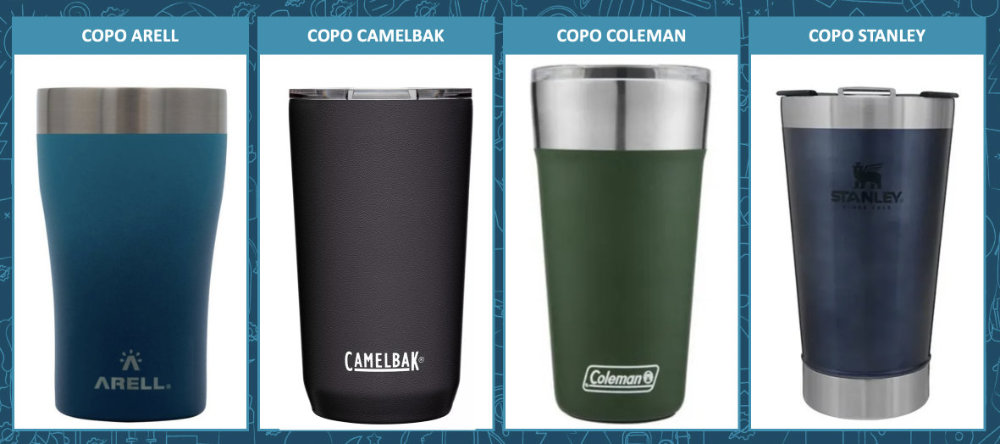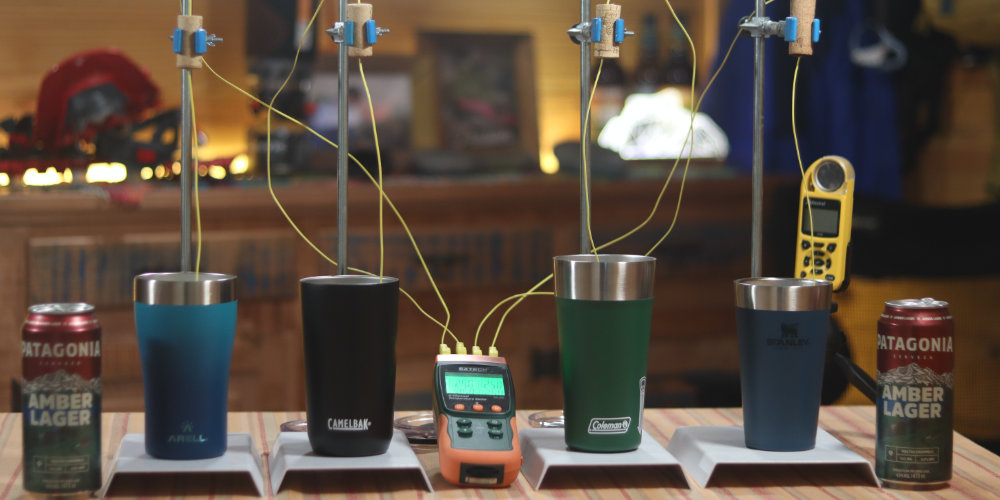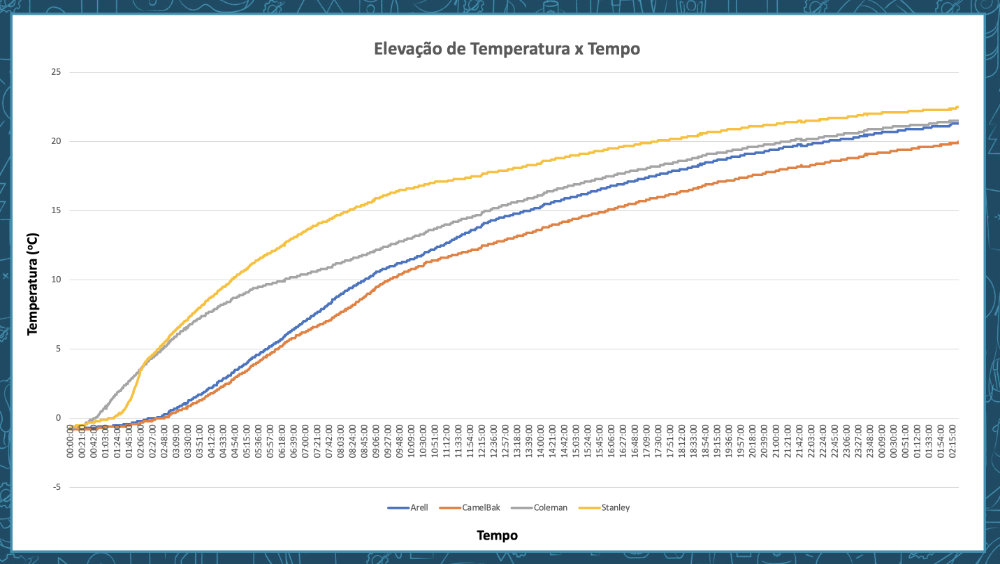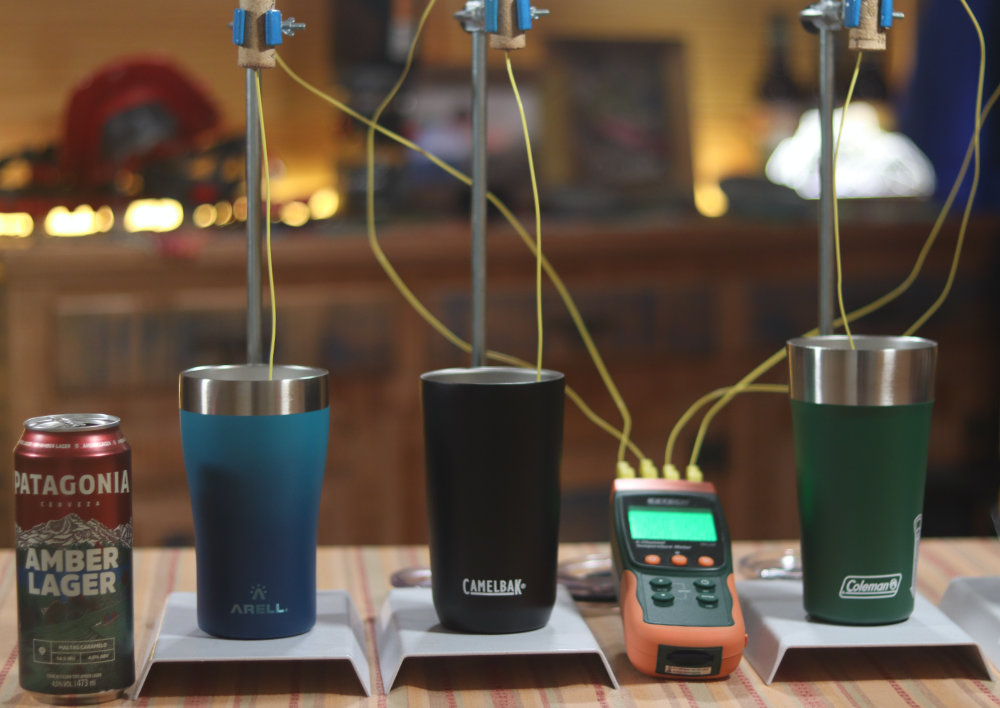If you follow our experiments and tests at the Gear Tips Lab, you’ve likely seen our videos and posts about thermal cups.
We initially conducted a comparative test between a glass cup and a stainless steel vacuum-insulated thermal cup from the brand 360º (a brand belonging to Sea to Summit), to show the difference in performance regarding thermal insulation and the temperature increase of the liquid (in this case, Patagonia beer) over time. The result was obvious: the thermal cup’s performance is far superior. But we didn’t stop there!
After this initial experiment, we conducted a comparative test between thermal cups from 360º, CamelBak, NTK, and Stanley. The results were impressive, showing that the most efficient thermal cup, both for cold and hot liquids, is the one from CamelBak. After publishing the video on our YouTube channel and the post on our website, we received a huge number of requests for new tests with cups from other brands. That’s why we decided to carry out the test, whose results are presented below.
But first, a few important considerations:
1 – Some people asked whether the lids of thermal cups influenced the test results, as each brand has slightly different lids. We were certain that for hot liquids, the lid made a difference. But for cold liquids, we weren’t sure. So, we conducted a comparative test with two identical thermal cups — one with a lid and one without. We chose the CamelBak cup for this comparison since it was the winner of the first comparative test.
We’re detailing this point to explain why, in this new test comparing cups from Arell, CamelBak, Coleman, and Stanley, we chose to run the test only with cold liquid, and removed the lids from all cups — precisely because they don’t significantly affect cold liquid performance.
2 – We included the CamelBak cup, winner of the previous comparative test, to see how it would perform against new contenders.
3 – Many people questioned whether the Stanley cup used in the first test was fake. The answer is no. It was not fake, but an older version. So, we decided to buy a current version of the brand’s cup and put it to the test in this new comparison.
4 – We decided the Arell and Coleman cups for this competition because they were the most requested by our YouTube audience. We’ll soon be conducting more tests with other brands, but only those officially distributed in Brazil.

We received many comments asking why we didn’t conduct the test at the beach, by the pool, or in a warm, sunny place — simulating the real-world use of thermal cups. That’s why it’s worth noting that this is the Gear Tips Lab, our testing lab, and there’s a reason for that.
As explained in other articles, one of the biggest challenges in equipment comparison is maintaining consistent conditions throughout the entire test and conducting the tests simultaneously whenever possible.
Additionally, defining specific parameters and conditions is essential for test replicability and for validating results or testing new thermal cups.
In the case of thermal cups, this is even more important due to the large number of models on the market. Our temperature measuring equipment has four probes, which allows comparison of only four cups at a time. If we couldn’t maintain consistent conditions across tests, we wouldn’t be able to compare so many models fairly.

– Average Ambient Temperature: 24.8 ºC
– Initial Temperature of Patagonia Amber Lager beer: -0.8 ºC
The test was conducted with all four thermal cups simultaneously to avoid any variation in the above conditions, since all cups were in the same room, at the same ambient temperature, and with the same liquid.
– Arell 500 ml 304 Stainless Steel Double-Wall Vacuum-Insulated Cup without lid
– CamelBak 500 ml 18/8 Stainless Steel Double-Wall Vacuum-Insulated Cup without lid
– Coleman 600 ml 340 Stainless Steel Double-Wall Vacuum-Insulated Cup without lid
– Stanley 475 ml 18/8 Stainless Steel Double-Wall Vacuum-Insulated Cup without lid

Gear Tips Lab set up for evaluating thermal cups from Arell, CamelBak, Coleman, and Stanley
We also used the following equipment from the Gear Tips Lab:
– Kestrel 5500 Portable Weather Station
– Extech SDL200 Four-Channel Digital Thermometer with Data Logger and Type K Thermocouple Sensor (-100 to 1300 ºC), 0.1 ºC resolution, ±1 °C accuracy
– Fluke 561 HVAC Pro Lasergrip Infrared Thermometer (-40 to 550 ºC), 0.1 ºC resolution, ±0.1 ºC accuracy
Thermal cup test with cold liquids
The first test was conducted using Patagonia Amber Lager beer. We started the test simultaneously with the beer at a temperature of -0.8 ºC. Below is a brief summary of the test:
Initial Beer Temperature: -0.8 ºC
Final Beer Temperature: 20 ºC
Measured Temperatures: 5 ºC, 10 ºC, 15 ºC, and 20 ºC
Experiment Start Time: 09h 13min 03sec
Experiment End Time: 11h 39min 03sec (next day)
Total Experiment Time: 26h 26min 00sec
In the graph below (Time vs Temperature Increase), we can clearly see that the cup with the best thermal efficiency is the CamelBak.

To help interpret the graph, below are the times it took for the beer in each cup to reach the defined temperature levels (5 ºC, 10 ºC, 15 ºC, and 20 ºC):
In the graph below (Temperature Increase vs. Time), we see another interpretation of the data, where it’s clear once again that the CamelBak and Arell cups had very similar thermal efficiency for cold liquids during the first 5 hours of the test — the two curves are nearly overlapping. Later on, the curves diverge, and the CamelBak stands out. Additionally, we see that the Coleman and Stanley cups do not perform well thermally, as the beer temperature rises significantly in the early hours of the test.

Thermal cup ranking for cold liquids
1st Place: CamelBak
2nd Place: Arell
3rd Place: Coleman
4th Place: Stanley

Arell, CamelBak, and Coleman thermal cups during testing
Thermal cup prices
The list below shows the current prices (October/2021) of the thermal cups tested in this experiment. Prices may vary between stores, and those shown are the brands’ suggested retail prices:
- Arell: R$ 159.00 (without lid — lid sold separately for R$ 49.00)
- CamelBak: R$ 239.90 (with lid)
- Coleman: R$ 199.90 (with lid)
- Stanley: R$ 199.00 (with lid and bottle opener)
Watch the full video of this thermal cup comparison!
Gear Members receive exclusive discounts on Outdoor Gear
Members of the Gear Tips Club get exclusive discounts on outdoor equipment, including products from CamelBak and Arell. Plus, special discounts on courses, experiences, stores, events, and access to exclusive Gear Tips content. Not a Gear Tips Club member yet? Sign up now!
This post is also available in: Português (Portuguese (Brazil)) Español (Spanish)
